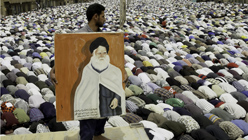March 20, 2013 will mark ten years since the United States invaded Iraq. As this inauspicious anniversary closes in, nagging questions about what we have accomplished and whom we have benefitted remain to be answered. We can start to quantify it in numerical terms: one tyrannical leader and his progeny captured and executed; 4,486 American military personnel killed during eight years of active engagement; anywhere from 110,00 to 127,000 Iraqi civilians killed, depending on the source referenced; $845 billion spent by the United States to support the war effort; zero weapons of mass destruction found.
It’s worth considering these figures because they will shape the wider narrative of the war as it passes into history. Notably absent from the numerical account of our latest military adventure are the finer details of the war’s impact. A few of those moments are presented in Eye Level in Iraq: Photographs by Kael Alford and Thorne Anderson, now on view at the de Young Museum of Art. Alford and Anderson, both freelance photojournalists, traveled to Iraq as the start of war was imminent. Although the pair had financial ties to and printed their work in outlets including Time magazine and the San Francisco Chronicle, Alford and Anderson also reported the stories that would not live long on the pages of western newspapers and magazines. For these “small” stories, photographed over the course of two years, their objective was to capture moments of both calm and catastrophe, such as men playing a game of dominos on a warm spring evening, and a father in newly fallen Najaf rushing across the street as his terrified child screams.
Kael Alford , Najaf, Iraq, August 21, 2004.
Alford and Anderson dug in deep when pursuing stories, making sure to spend as much time as possible with the people they were photographing. That tenacity proved beneficial, as the pair were two of a handful of photographers granted access to the Mahdi Army, the militant force galvanized by Muqtada al-Sadr as he opposed the American invasion. What is transmitted — both in the images they captured and lucid descriptions of time spent in a war zone — is that the people caught up in Operation Iraqi Freedom paid for their liberation with relative stability and safety, currency that is valuable to all.
Kael Alford, Baghdad, Iraq, August 14, 2004.
Another story Alford and Anderson recount speaks to the aftermath of a US missile strike in a busy market in Shoala, a city north of Baghdad. Captured during the 21-day “shock and awe” campaign designed to prime (read: weaken and demoralize) the region prior to the ground assault, the trio of images features a family mourning the death of its youngest member. Eight-year-old Zahraa al-Mousewi bled to death internally as her family looked on. In one photograph, we see her older brothers, grown men, crying helplessly over her body, and in another we see an elderly woman who attends the body as it is washed prior to burial. In the third image, taken during Alford’s return visit to Iraq in 2011, we see a man and young girl seated before the camera. The girl, verging nervously on womanhood, was the youngest survivor of that same missile strike that claimed her aunt and mother.


